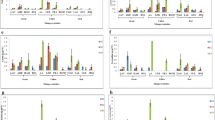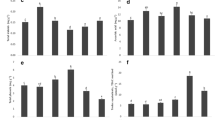Abstract
The fruits of several species of the Aronia genus were studied in the content of anthocyanins and chlorogenic acids. It was found that errors in determining the Aronia species can be excluded by using quantitative ratios between the main anthocyanins—cyanidin-3-galactoside (Cy3Gala, the main component), cyanidin-3-arabinoside (Cy3Ara), cyanidin-3-glucoside (Cy3Glu) and cyanidin-3-xyloside (Cy3Xyl). The highest level of anthocyanin accumulation was found for Aronia melanocarpa (Michx.) Elliott fruits. Meanwhile for the species differentiation the least accumulation in fruits of Cy3Glu (no more than 0.8% of the total anthocyanins) and Cy3Xyl (not more than 1.5 mol % of the amount of anthocyanins) may explored in comparison with that of A. prunifolia (Marshall) Rehder and A. mitschurinii A.K. Skvortsov & Maitul., the latter being often mistaken for black chokeberry. Even more reliable for the differentiation is the content and ratio of isomeric chlorogenic acids in the fruits. So, fruits of A. melanocarpa accumulate as the main chlorogenic acid 3-caffeoylquinic acid (3CQA, about 69.4 mol % of the sum of chlorogenic acids) and, in smaller but comparable amounts 5-caffeoylquinic (5CQA) and 4-caffeoylquinic (4CQA) acids, which account for about 14 mol %. In fruits of other species of chokeberry accumulation levels of 3CQA and 5CQA are comparable, but may vary with the change of the dominant one, while the accumulation 4CQA is characteristically low (less than 3.5 mol %). The paper discusses and experimentally confirms some errors in the sample preparation of Aronia fruit samples before the qualitative and quantitative determination of anthocyanins, and proposes a method of excluding them.




Similar content being viewed by others
REFERENCES
Safronova, I.V., Kozlov, V.A., Gol’dina, I.A., and Gaydul’, K.V., Black chokeberry: biological activity and prospects for use in medicine, Innovats. Prodovol’stv. Bezop., 2014, no. 3, pp. 32–43.
Kuklina, A.G., Naturalization of Michurin’s chokeberry in the forests of European Russia, Lesokhoz. Inform., 2015, no. 2, pp. 46–56.
Brand, M.H., Connolly, B.A., Lanfang, H., Levine, L.H., Richards, J.T., Shine, S.M., and Spencer, L.E., Anthocyanins, total phenolics, ORAC and moisture content of wild and cultivated dark-fruited Aronia species, Sci. Horticult., 2017, vol. 224, pp. 332–342, https://doi.org/10.1016/j.scienta.2017.06.021
Tsvelev, N.N., Flora Vostochnoi Evropy (Flora of Eastern Europe), St. Petersburg, 2001, vol. 10, pp. 555–556.
Wangensteen, H., Bräunlich, M., Nikolic, V., Malterud, K.E., Slimestad, R., and Barsetta, H., Anthocyanins, proanthocyanidins and total phenolics in four cultivars of aronia: Antioxidant and enzyme inhibitory effects, J. Funct. Foods, 2014, vol. 7, pp. 746–752, https://doi.org/10.1016/j.jff.2014.02.006
Leonard, P.J., Brand, M.H., Connolly, B.A., and Obae, S.G., Investigation of the origin of Aronia mitschurinii using amplified fragment length polymorphism analysis, HortScience, 2013, vol. 48, pp. 520–524.
Szopa, A., Kokotkiewicz, A., Kubica, P., Banaszczak, P., Wojtanowska-Krośniak, A., Krośniak, M., Marzec-Wroblewska, U., Badura, A., Zagrodzki, P., Bucinski, A., Luczkiewicz, M., and Ekiert, H., Comparative analysis of different groups of phenolic compounds in fruit and leaf extracts of Aronia sp.: A. melanocarpa, A. arbutifolia, and A. ×prunifolia and their antioxidant activities, Eur. Food Res. Technol., 2017, vol. 243, pp. 1645–1657. https://doi.org/10.1007/s00217-017-2872-8
Vinogradova-Maitulina, Y., Grygorieva, O., Vergun, O., and Brindza, J., Morphological characterictics for fruits of Aronia mitschurinii A.K. Skvortsov & Maitul, Potravinarstvo Slovak J. Food Sci., 2017, vol. 11, pp. 754–760. https://doi.org/10.5219/845
Deineka, V.I., Sidorov, A.N., Deineka, L.A., and Tynyanaya, I.I., Sample preparation for HPLC determination of anthocyanins and betacyanins. Sample solvent effect, Sorbts. Khromatogr. Protsessy, 2016, vol. 16, no. 3, pp. 384–389.
Deineka, L.A., Blinova, I.P., Kul’chenko, YA.I., Ozer, P.S., Saenko, I.I., and Deineka, V.I., Preservation and transition between forms of anthocyanins in solutions, Uspekhi Sovremennogo Estestvoznaniya, 2016, no. 2, pp. 16–20.
Logvinova, Ye.Ye., Brezhneva, T.A., Slivkin, A.I., Samylina, I.A, and Berest, I.S., Selection of optimal conditions for the extraction of anthocyanin compounds from dried and freshly picked fruits of mountain ash, Vestn. VGU, Ser. Khim. Biol. Farm., 2014, no. 1, pp. 122–125.
Logvinova, E.E., Brezhneva, T.A., Slivkin, A.I., Perova, I.B., and Eller, K.I., Comparative analysis of anthocyanin compounds of aronia fruits of different cultivars by HPLC, Sorbts. Khromatogr. Protsessy, 2017, vol. 17, no. 1, pp. 117–121.
Challice, J.S., Phenolic compounds of the subfamily Pomoidaea: A chemosystematic survey, Phytochemistry, 1973, vol. 12, pp. 1095–1101, https://doi.org/10.1016/S0031-9422(00)91339-6
Szopa, A. and Ekiert, H., Production of biologically active phenolic acids in Aronia melanocarpa (Michx.) Elliott in vitro cultures cultivated on different variants of the Murashige and Skoog medium, Plant Growth Regul., 2014, vol. 72, pp. 51–58, https://doi.org/10.1007/s10725-013-9835-2
Shan, Y., Jin, X., Cheng, Y., and Yan, W., Simultaneous determination of chlorogenic acids in green coffee bean extracts with effective relative response factors, Int. J. Food Prop., 2017, vol. 20, pp. 2028–2040. https://doi.org/10.1080/10942912.2016.1230746
Author information
Authors and Affiliations
Corresponding author
Ethics declarations
COMPLIANCE WITH ETHICAL STANDARDS
This article does not contain any studies involving animals or human participants performed by any of the authors.
Conflict of Interests
The authors declare that they have no conflict of interests.
Additional information
Translated by P. Vlasov
Rights and permissions
About this article
Cite this article
Deineka, V.I., Tretyakov, M.Y., Oleiniz, E.Y. et al. Determination of Anthocyanins and Chlorogenic Acids in Fruits of Aronia Genus: The Experience of Chemosystematics. Russ J Bioorg Chem 46, 1390–1395 (2020). https://doi.org/10.1134/S1068162020070031
Received:
Revised:
Accepted:
Published:
Issue Date:
DOI: https://doi.org/10.1134/S1068162020070031




